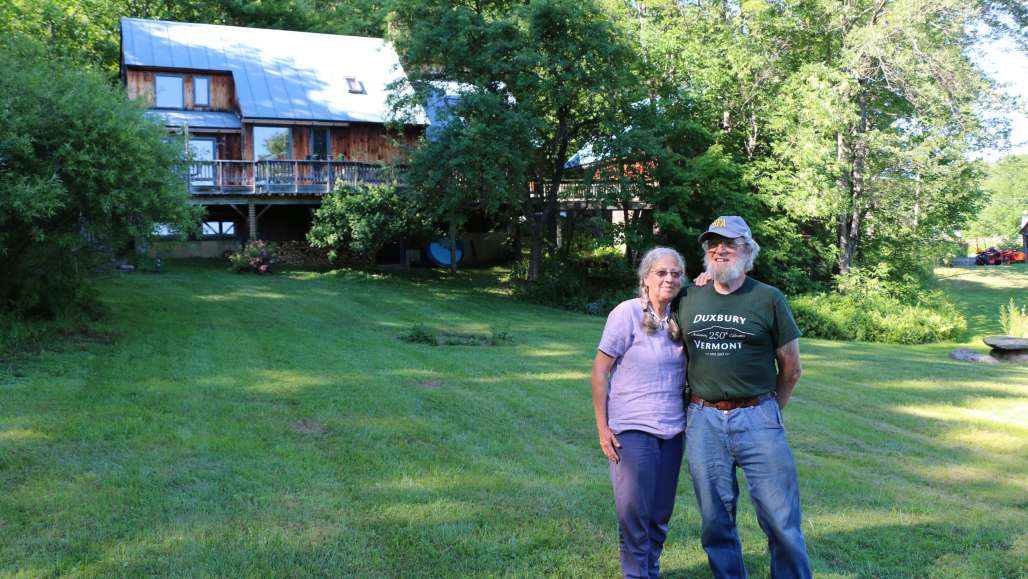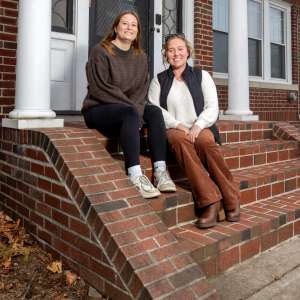Hands on: Building a House and Living in It Too

It’s not a metaphor when Fred and Carol (Johnson) Collins talk about their relationship in terms of a house. The 1969 graduates designed and built their own home in South Duxbury, Vermont, two years after their wedding, and since then they’ve been making adjustments, additions, and changes to it to accommodate their growing and changing needs.
Building and then living long-term in a house, says Carol, “means maintaining. It’s meant ripping off and adding on. The house is so much about us, and about our marriage.”
Over 48 years, they’ve raised a son and daughter, launched home-based small businesses (wool crafts for Carol and furniture building for Fred), grazed sheep and planted fruit and vegetables on their land, and built a house across the street for Carol’s parents, where her mother, 104-year-old Wanda Johnson ’64, still lives.
But let’s back up to the beginning. The story of the marriage dates to the 1960s, when two Vermonters, the son of a builder and the daughter of farmers, met as students at Keene State. Fred Collins was studying industrial arts education, and Carol Johnson liberal arts and English literature. The year after they graduated, they were married by Fred’s grandfather, a justice of the peace.
The story of the Collins house starts in 1972, when both Fred and Carol were teaching at Harwood Union High School, just down the road from the piece of property they’d purchased. At the end of each school day, on weekends, and during the summer, they hammered and sawed and muscled beams into place, putting together the post-and-beam house they’d sketched out after doing some research and factoring in materials on hand – including timbers from a building Fred’s father had dismantled.
They’d hired professionals to excavate and pour the concrete foundation, but otherwise did the work themselves, occasionally pressing into service friends and colleagues who stopped by (including the superintendent of schools and school board chair).
They moved in before the house was finished. Initially, only the upstairs bathroom was plumbed, and they’d lug their dishes up to the bathtub to wash them. That required climbing a ladder propped in a circular hole in the floor below and ceiling above, designed to accommodate a spiral staircase – which now serves as a centerpiece for the house but was still just a drawing early on.
They disagreed on some things, and made some compromises that they’ve managed to live with, even if neither of them was fully satisfied. Carol wanted open shelves in the kitchen; Fred wanted closed cabinets to keep off the dust.
“They do get dusty,” Carol says. “But I really wanted the things of our life to be the decoration of the house.”
And so they are. A wall in the living room is a patchwork of family photos. Drying cobs of corn waiting to be ground hang from a ceiling beam. Children’s drawings decorate the back of a bathroom door. And everywhere are things they’ve made with their own hands: Fred’s fine furniture; Carol’s woolen blankets.
The stuff of their lives.
As they lived in the house, they corrected some mistakes. “We put a row of windows on the north side up in the peak, to light the balcony,” Fred remembers. “In the winter, the heat would go up there, and the water would condense on those windows and run down the walls. So we cut the top of the house off.”
They also made changes and additions. They moved the laundry room into the basement to create an office space for Carol, and later expanded and converted the garage to serve as a shop and studio for her Singing Spindle Spinnery business. A replacement garage also houses Fred’s woodworking shop. A bump-out in the master bedroom provides a walk-in closet.
“) Fred and I are proud of having built our own home, and we love it. Not everyone can do it, and fewer and fewer people are doing it today,” says Carol. “Because we built our home ourselves, we remember the hard work and our hard-earned money that went into it. That experience makes us want to respect our home and care for it.”
Fred had a long career teaching industrial arts and building trades – he qualified for the latter by documenting his work on the house – and then went on to build custom furniture. Carol left her job teaching English and creative writing to raise her family and to teach spinning and other crafts. She sells her work, along with seeds, plants, and herb teas from the garden. A tiny shop at the entrance to their driveway offers wares from Singing Spindle Spinnery.
Their lives are full and busy these days with the work of caring for Carol’s mother; they are also looking after Felix, one of their two grandsons, one day a week. What does the future hold for them – and for their house? Carol likes the idea of building a smaller house on their property and using their current house as a common space for a co-housing community. Fred’s not so sure.
One thing is certain, though: “When you build the house yourselves, you’re never done,” says Fred.





